Biography
1921
Pierre, Ladislas Kijno was born in Warsaw on June 27, 1921. His mother, Claire Haze, was French (born in Barlin near Béthune) and his father, Joseph Kijno, was Polish. On the Polish side of the family, they were revolutionaries and patriots for generations. “His great-grandfather was assassinated by the Cossacks at the” organ of his village; Kijno’s father, first prize in violin at the Warsaw Conservatory, was arrested during the 1905 uprising and deported to Siberia, from where he escaped.
1925
After a long emigration that took them through Canada, Joseph Kijno and his family settled permanently in 1925 in Nœux-les-Mines in northern France. Josef Kijno worked in the coal mines and taught violin in the evenings.
Young Kijno’s maternal grandfather, a blacksmith, poet, and philosopher, had a very strong influence on him and raised him in the purest Rousseauist tradition. He developed a passion for drawing very early on. From his childhood, he constantly sketched everything around him: musicians, pianos, violins, and life in the mining communities in which he participated: miners, slag heaps, mine headframes, horses, barges, etc…
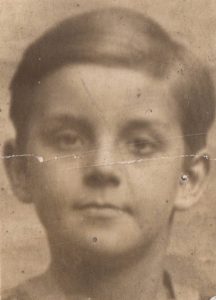
(Kijno as a child)
1930
He loses his grandfather. This first contact with death leaves him terribly shaken.
1936
As a boarder at the minor seminary in Arras, he excelled in classical studies. He continued to draw and at 15 created a series of charcoal allegories on the theme of music and fortresses. In a magazine he found by chance in a dentist’s waiting room, he discovered Picasso and Edouard Pignon’s studies of miners’ heads.
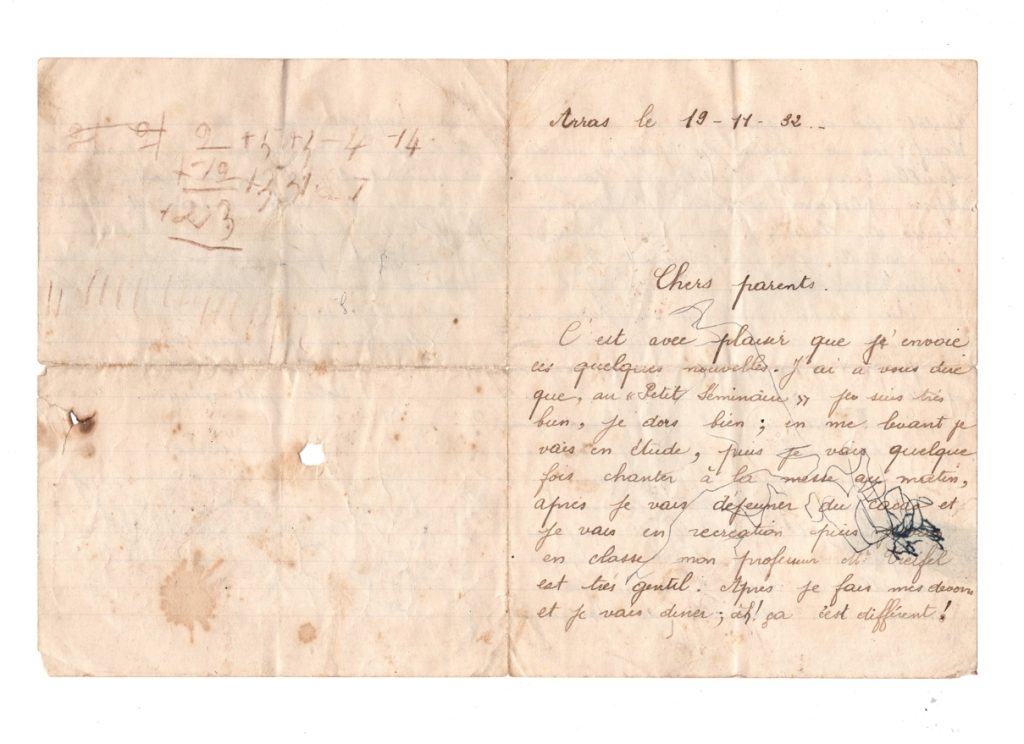

(Letter from Pierre Ladislas Kijno to his parents, 1932)
1938
The artist passionately pursued his literary and philosophical studies at the Catholic Faculty of Lille in Abbé Vancourt’s class, who introduced him to Jean Grenier, Albert Camus’s mentor. During his studies, he also met Gabriel Marcel. Jean Grenier and Gabriel Marcel had a strong influence on him. He continued to paint on the theme of quartets.
1938-1942
After a painful mystical and metaphysical crisis, Kijno fell seriously ill and was obliged to make numerous stays in sanatoriums, at Sancellemoz on the Assy plateau in Haute-Savoie, until 1954. He exchanged letters with Paul Claudel. At Sancellemoz, he met the writer Pierre Marois who introduced him to the world of Van Gogh, Cézanne, and Bonnard. His doctors, Dr. Tobé and Dr. Degeorges, encouraged him in his first pictorial research.
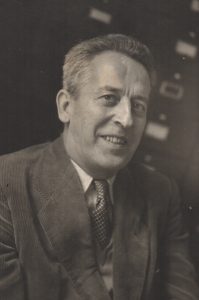
(Pierre Marois, Kijno’s mentor for painting and poetry at the Sanatorium of Praz-Coutant, Haute Savoie, 1943)
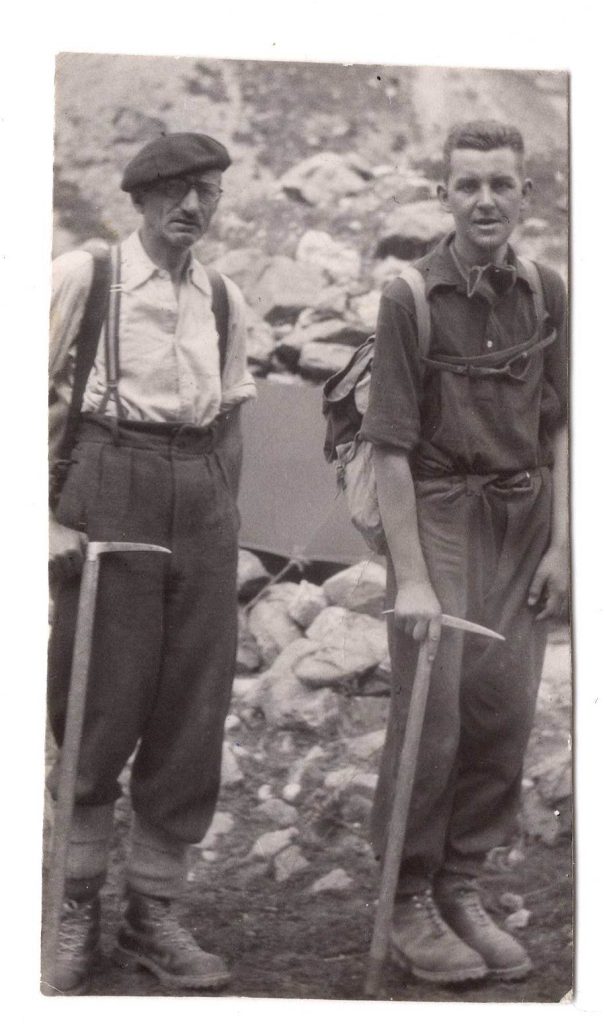
(Kijno at the sanatorium)
1943
First exhibition at the Sancellemoz clinic on the theme of chess games where the relationship between lines and curves imposes itself on him in a structured way. He begins a correspondence with Paul Claudel and discovers Aragon’s Brocéliande and Francis Ponge’s Le Parti Pris des Choses. Kijno then considers the problem of illustrating these texts, on which he would work for more than twenty years.
1945
He becomes an activist with a pacifist group close to the ideas of Gandhi and Lanza Del Vasto.
1946
In his painting, he begins his first research on crumpling, on the interferences between smooth and crumpled. “The child, he says, is born crumpled, the adolescent becomes smooth, the old man dies crumpled”. This experience would make him internationally known. He completes his philosophy degree, frequents the Centre Noroît created in Arras by Léonce Petitot where he meets Bernard Dorival and Gabriel Marcel.
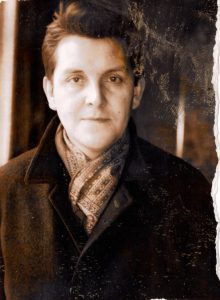
(Kijno in Lille in 1947)
1947
Through one of his students, Claude Mary, he visits Germaine Richier’s studio, who advises him to devote himself definitively to painting. Germaine Richier and her husband René de Solier nurture his taste for painting throughout their friendship and long discussions.
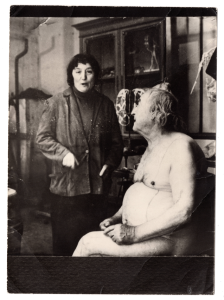
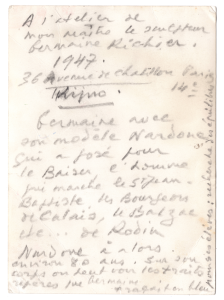
(Photo of Germaine Richier and her model Nardone annotated by Kijno)
1949
Exhibits at the Salon des Indépendants in Paris. At the request of Canon Devemy and Father Couturier, Kijno creates a Last Supper for the crypt of the church in Assy. From this experience, he notes, his painting will shift towards demiurgy, the sacred, and magical resonance. Since 1942, Kijno had experienced the entire process of integrating modern art into the church of Assy. Rouault, Bonnard, Matisse, Lurçat, Bazaine, Braque, Germaine Richier, Fernand Léger, Lipchitz, Chagall largely contributed to this under the impetus of Canon Devemy and Father Couturier.
1954
He marries Malou Kerdavid, an Air France flight attendant, the sole survivor of the 1946 Paris-London accident, whom he met in 1949 at a sanatorium. This marriage restores his original name Kijno, which had been transformed into Kyno by the Civil Registry. The couple settles in the Bay of Mont-Saint-Michel. From 1954 onwards, Kijno will only paint. In the Bay of Mont Saint Michel, he analyzes the rhythms of the sea, the rocks, and the large sandbanks around Granville. He paints his first “pebbles” in November, he exhibits at the Saint-placide gallery in Paris, where he is noticed by Franck Elgar, who proposes him for the critics’ prize.
1955
He decides to burn everything he has done, over two hundred paintings and drawings.

(Kijno at Saint Jean Le Thomas in 1955 at the Château de Montmélian, commissioned for a work titled The Burial for the château owner.)
1956
S “ettles in Antibes shortly after Nicolas de Stäel’s suicide. Exhibition at the Kamer gallery in Paris with Arnal, Bellegarde, Bertini, Hundertwasser, and Sugaï. First studies on fig trees and pebbles. He befriends poet Andre Verdet who shows great interest in his experiments, with” Cretan writer Nikos Kazantzakis, Hans Hartung and Alberto Magnelli, Gastaud, Sapone, Luc Fournol, Jacques Damase, Kamer, Roger Vivier, R. Hauert, C. Bourdet, Audiberti, the Bouthoul’s, the Bourgois’, Prévert, R. Laporte, P. Roux, the Régnier’s, the Najar’s, the Coiraton’s, the Radix’s, G. Lanvin, Marguerite and Aimé Maeght, Marianne Greenwood… He meets Picasso several times.
Purchase of a large canvas by the Museum of Modern Art. Kijno deepens his research on curved rhythms and their extraordinary morphological versatility. He creates highly architectural canvases in very sober tones. Use of glycerophthalic paints. Pebble experiment with René de Solier: attempt to clarify pebbles through signs and shapes.
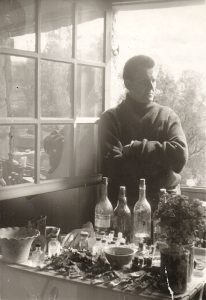
(Kijno in Antibes in the studio lent by Mrs. Coiraton (from 1956 to 1958)

(Kijno drawing in 1956 in Antibes)
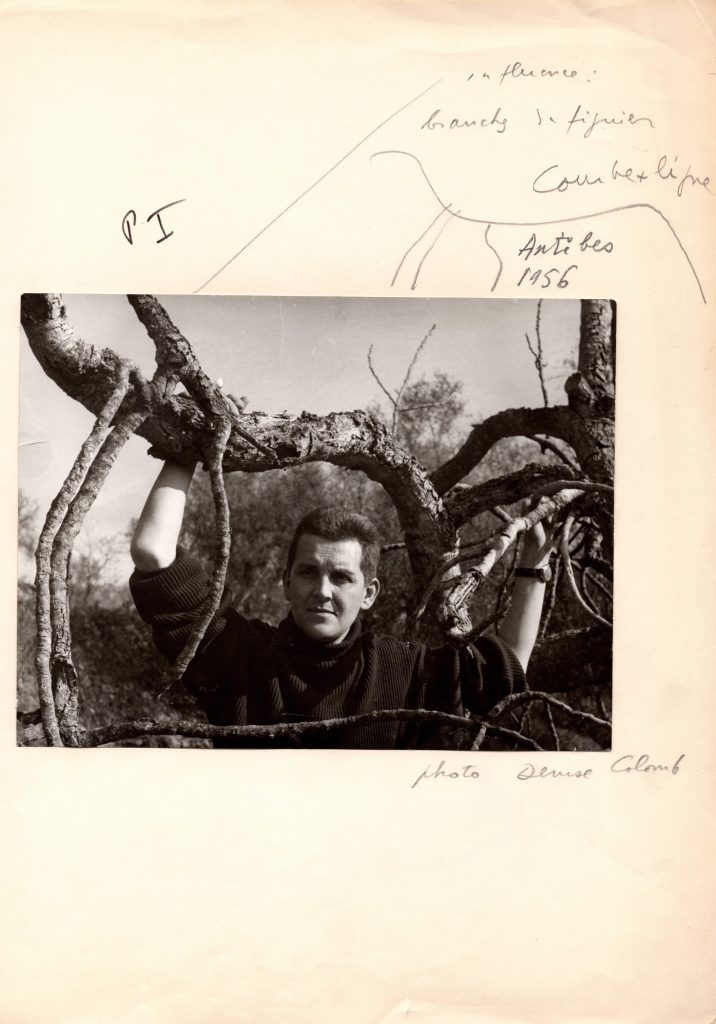
(Photo of Kijno by Denise Colomb in 1956 in Antibes)
1957
In September 1957, after an Atlan exhibition, the curator of the Antibes museum, Dor de la Souchère, presents Kijno’s series of paintings of Antibes pebbles. This exhibition consists of canvases, gouaches, painted pebbles, crumpled papers, illustrated books – particularly on texts by Kazantzakis. Henri Bénézit sees the exhibition and offers to exhibit it in Paris. Exhibition at Henri Bénézit gallery in Paris. Preface written by Paul Gay. Stay in Madeira where he is struck by the enormous volcanic pebbles of Funchal Bay and their interference with clouds. The complex elements of the visible world – nature, man, machine – seem to him to be linked by articulations he would like to discover. He begins work on black and rounded forms. Meets filmmaker Henri Georges Clouzot. Paints a metal background for a slate sculpture by Germaine Richier The Desert Rose.
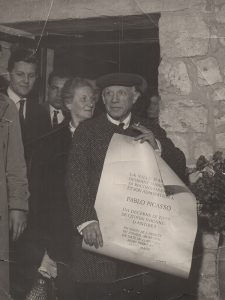
(Presentation of the title of Honorary Citizen of Antibes to Picasso in 1957. Kijno was among Picasso’s invited guests, whom he appreciated.)
1958
Kijno settles in Paris. Exhibition at Henri Bénézit gallery in Paris, of the Funchal pebbles series. Extending his metaphysical quest, Kijno concerns himself with the magical rites of all civilizations, particularly those qualified as primitive. Technically, he continues developing crumpled papers and canvases in the dynamics of vaporization. As part of art in the village, he decides with Dr. Paul Gay to create the Cadran group, bringing together painters of various tendencies. Through philosopher Jean Grenier, his mentor, he meets Henri Dupont. The latter has contributed to the development of major contemporary art collections in the north by introducing notably Fernand Léger, Estève, Poliakoff, Viera da Silva, Atlan… Henri Dupont takes Kijno into his team.
1959
Exhibition at the May Salon, invited by Germaine Richier. Exhibition of his illustration projects for Nikos Kazantzakis’s Ascesis at François Maspéro’s in Paris. Collective exhibition School of Paris presented in Warsaw by Jean Cassou. Writes an article on Germaine Richier, published in Jean-Jacques Lévèque’s review Plastic Sense. Participation in the exhibition Painters of Today France-Italy in Turin with Herbin, Zao Wou-Ki, Kermadec, Deyrolle, Maryan, Debré. Group exhibition at the Ancient Comedy gallery in Paris with Geneviève Asse, Istrati, Lardera, Madeleine Grenier…

(Kijno, Germaine Richier and Malou, 1957, Antibes)
1960
Settles in Condé-sur-Vesgre in the Rambouillet forest. He begins the series of white writings and develops serial variations around the motif. In Paris, he creates his first political graffiti on the walls of the Latin Quarter. Jacques Damase’s book, Kijno’s drawings published by Tisné, is selected among the fifty best books of the year at La Hune in Paris. Exhibition of crumpled papers at the Numaga gallery in La Chaux-de-Fonds (Switzerland). Exhibition Germaine Richier’s studio at the Creuzevault gallery in Paris. Exhibition Pierre-Jean Oswald presents his authors and illustrations at the A.G. gallery on Rue de l’Université in Paris. Laubiés, Ferro (later known as Erro), Matta, all activists against the Algerian War, participate. Kijno presents graphic interventions on Henri Kréa’s poems. Exhibition Young French Painters in the United States. It features twelve painters presented by Bernard Dorival, curator of the National Museum of Modern Art. Exhibition Aspects of Contemporary Art organized by Sens Plastique at the University of Caen with Alechinsky, Benrath, Bertini, Corneille, Fichet, Gastaud, Grenier, Hartung, Laubies, Rancillac, Tyszblat. Sculptures by Painters where he exhibits two sculptures, one in pure metal and the other polychrome, at the Claude Bernard gallery in Paris. Part of the group Presence in Abstraction at Marcelle Dupuis, with Bellegarde, Benrath, Bryen, Dubuffet, Fautrier, Hartung, Lanskoy, Laubies, Manessier, Messagier, Matta, Michaux and Ubac. Exhibition at the Motte gallery in Geneva.

(Kijno and Canon Devémy in 1960)
1961
New Realities Kijno’s first solo exhibition at the Henri Dupont gallery in Lille. School of Paris at the Charpentier gallery in Paris. Each year from 1953 to 1963, the gallery presents different currents of “French tradition”. The Revenants, exhibition organized at the Antibes museum by Dor de la Souchère. Thirty-six Contemporary Drawings, group exhibition at the Jacques Massol gallery in Paris.
1962
In what he calls his “mental speleology”, Kijno delves deeper and deeper into magical rites, the sense of cultural mixing, and the relationship of art with the collective unconscious. The spherical form becomes a leitmotif in his formal language.
Meets Sonia Delaunay through Jacques Damasse.
He will continue to see her until her death. Sonia Delaunay will lend him Robert Delaunay’s studio (rue Vercingétorix in Paris) which was frequented by Mondrian, Arp, and Mansouroff. Presentation of thirty canvases at the Henri-Creuzevault gallery in Paris.

(Kijno and Sonia Delaunay in 1972)
1964
First appearance in Kijno’s work of the themes of cosmonauts, cup-and-ball toys, and the conquest of space. Series of exhibitions in South America, including at the University of Puerto Rico museum. Participation in the annual salon of Gravelines (Nord) with Poliakoff, Gillet, Vieira da Silva, Key Sato, Lagage, Van Heck, Istrati, Zack. Some Aspects of Figuration in Contemporary Painting, Henri Dupont gallery in Lille. This involved the presentation of old canvases. Participation in the first exhibition of the Saint-Paul-de-Vence school. Exhibition Art and the Algerian Revolution in Algiers, which brought together painters who had campaigned for Algeria’s independence.
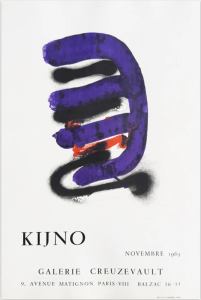
1965
Kijno develops large figural or emblematic forms and then elaborates grand cycles of allegorical character. Magic of the Object at the Henri Creuzevault gallery in Paris. Matta presents the Cosmonaut’s Cradle and Kijno The Poet’s Coffin which will lead to a violent polemic in international criticism. Meets Florence Garnier and Olivier Pinton and creates with them a tapestry woven in Aubusson. Exhibition at the Cercle Noroît in Arras. The preface-book accompanying Kijno’s drawings is written by Henri Kréa. He participates on this occasion in numerous debates on the theme of painting and poetry in the mining regions: Lens, Douai, Béthune. Beginning of the series The Horrible Emblems of War, and Variations on Jazz. Encounters in Front, series of exhibition-debates at the Henri Bénézit gallery in Paris. Jacques Perry asks him to participate in his novel The Life of a Pagan and in the staging of his play The Equation with Pierre Fresnay.

(Kijno projects painted, scratched, and perforated slides on faces, Centre Noroît, Arras, 1965)
1966
Forty painters inspired by jazz, at the Zunini gallery in Paris. Group exhibition organized by Mrs. Tubiana and Georges Lamiot at the Relais Bisson. Group exhibition, under the aegis of t “he union of plastic arts”at the Château d’Angers. Group exhibition art in the village at the town hall of Boège (Haute-Savoie). Exhibition of thirty carpets commissioned and published by Jacques Damase at Knoll in Paris. Animation of introductory painting workshops for minors, workers, and teachers in Boulogne-sur-Mer. Books and tapestries, exhibition at the Staatliches Museum in Berlin with Sonia Delaunay and Atlan organized by Jacques Damase. Creation of two mosaics 25 m long and 11 m high for the decoration of the gymnasium in Juvisy-sur-Orge (Essonne), architect Paul Ohnenvald.
1967
Orientation table for contemporary sculpture at the Henri Creuzevault gallery in Paris, conceived by Jean-Jacques Lévèque. Presentation of a structure made of cork balls painted white, which initiates the series of canvases variations on structure 21.
1968
Intellectuals’ Day for Vietnam bringing together 200 painters exhibiting a canvas in tribute to the Vietnamese people at the Palais des Sports in Paris. Creation of a cover for Clarté. Debate with students from the Faculty of Sciences of Orsay. Vision 68, exhibition-debate organized by Jean-Jacques Lévèque and Jean-Dominique Rey, in the jeu de paume room of the Château de Fontainebleau. May-June Kijno participates with Manessier, Singier, Soulages, Gastaud… and about one hundred and sixty painters in the formation of an artists’ union.

(René de Solier, Germaine Richier and Kijno)
1969
Participation in the jury of the painting prize of Vitry-sur-Seine as a founder, alongside Bryen, Chavignier, Labisse, Pignon, Singier, Bram van Velde, and Xenakis … Winner of the annual prize of the Society for the Encouragement of Art and Industry in Paris, for mural art with architect Johnson and Matra. Kijno begins the theme of beacons.
1970
Kijno takes an active part in the movement aiming to have the Ministry of Cultural Affairs obtain 1% of the national budget to ensure the decoration of buildings. Creation of a mosaic, with Luigi Guardigli, for a social housing tower in Vitry. Group exhibition on the theme art and the city in Pantin. On the traces of black and white, group exhibition at the House of Arts and Leisure in Thonon-les-Bains and at art in the village in tribute to Dr. Paul Gay. Meets Raoul-Jean Moulin who will become Secretary General of the International Association of Art Critics (AICA).
1971
Retrospective at the Museum of Fine Arts in Le Havre.
Angela Davis’s struggle inspires a new theme for Kijno. The Last Supper, created in 1949 for the church of Assy, as well as works by Lurçat, Léger, Germaine Richier, Matisse, Rouault, Bazaine … Are classified as historical monuments.

(Kijno at the Le Havre museum, 1971)
.
1972
Stays in Japan, where he discovers the Ryōan-ji garden, and in Moscow where he has the revelation of Andrei Rublev’s icons, particularly the Holy Trinity.
1973
Stays in California, Mexico, and New York. Following a violent health relapse, he is hospitalized at the Pitié Salpetrière in Paris, in the service of his friend, Professor Jean-Paul Camus, who has been interested in his painting since 1960.
1974
Kijno leaves Condé-sur-Vesgre (Yvelines) to settle in Saint-Germain-en-Laye.
1975
Beginning of the Neruda series. For the Neruda series, he definitively perfects the technique of crumpling canvases, developed since 1956.

(Antoni Clavé, Hans Hartung and Kijno, Sapone Gallery, Nice)
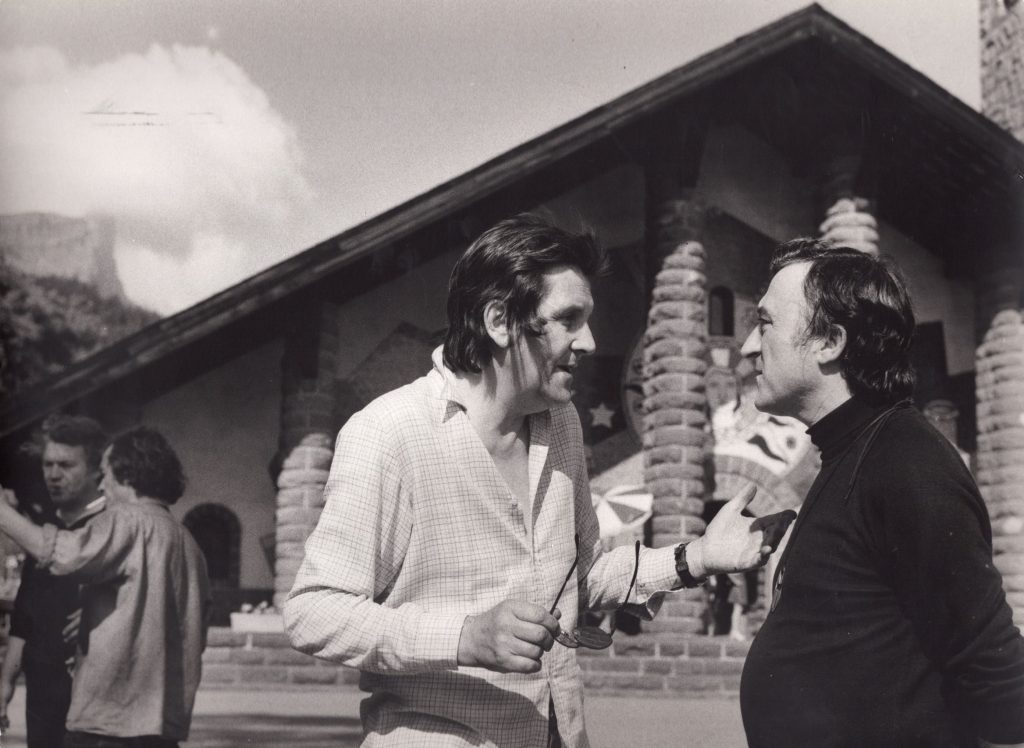
(Kijno in Assy (in the background: Pierre Gastaud and Michel Guino), 1973, photo André Villers)
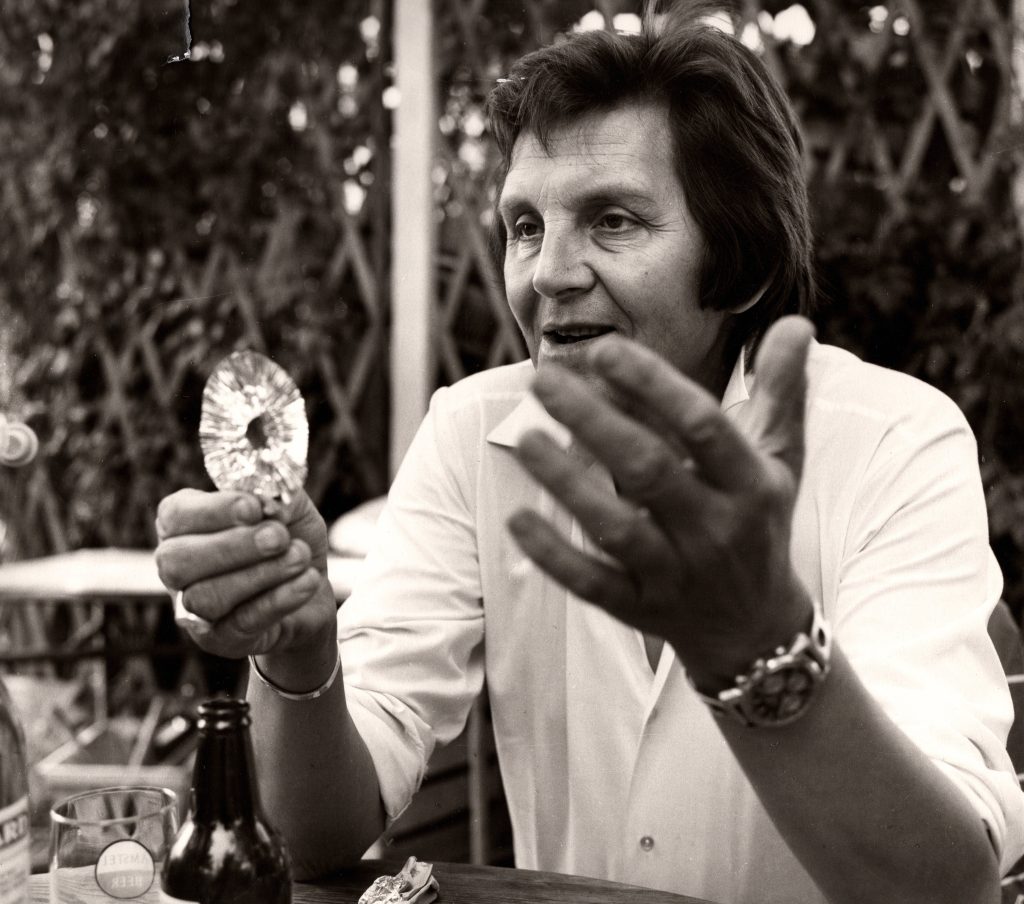
(Kijno at Pierre Gastaud’s in 1975, photo André Villers)
1976
Series of Steles for Neruda
1977
Series of Steles and Banners for a Burnt Forest.
Angela Davis’s press conference in Kijno’s studio in Saint-Germain en Laye
1978
Series of Horrible Blazons of War.
1980
Thirty crumpled canvases (6m x 1.20 m) compose Neruda’s theater presented at the French pavilion of the Venice Biennale by Gilles Plazy, curator. of engraving in Krakow, Poland.

Malou Kijno and a friend at the Venice Biennale in 1980
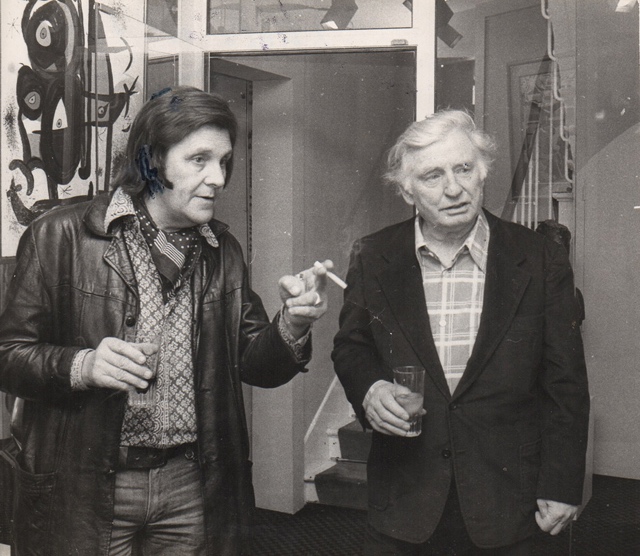
Kijno and Edouard Pignon
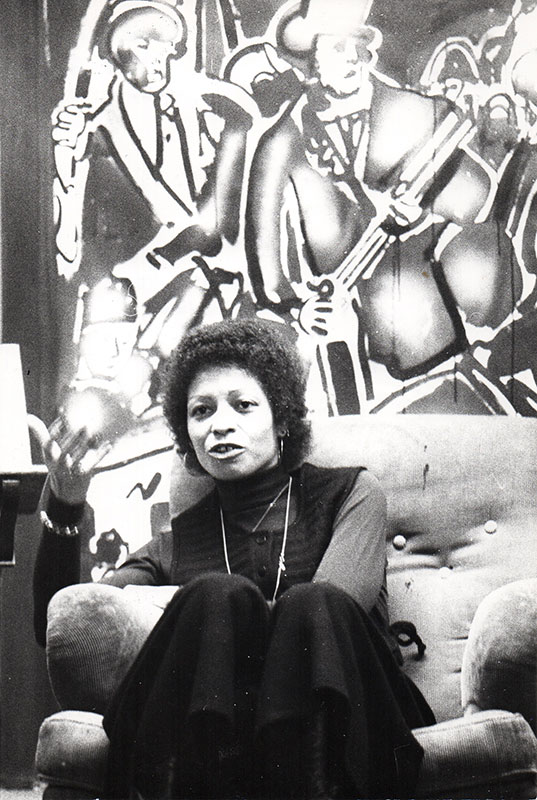
Angela Davis in Kijno’s studio in 1977
1981
Pollution or Nothing but the Death of the Tree, poem by Jean-Pierre Lemesle illustrated by Kijno.
Numerous exhibitions in Italy.
1982
Numerous work stays in Italy. Continues to campaign for human rights, particularly for those of artists in society. Performance with his Polish friend Tomek Kawiak on a small island in Guadeloupe.
1983
Exhibition of Kijno’s variations on the Riace bronzes, organized by Lydia Orlova-Artias at the Palazzo Comunale in Numana (Italy). After a stay in China in the spring, accompanied by his friend, the painter Chu Teh Chun, he begins the realization of his great thematic cycle “Return from China”.
1984
Jean-Claude Casadesus conducts Carmen at the Orange Theatre. Alongside the National Orchestra of Lille are Barbara Hendricks, Carreras, Van Dam. During rehearsals, Kijno creates an important series of drawings around this opera. He becomes friends with the conductor. Trip to Egypt, to Luxor and Karnak where he works on hieroglyphs and signs in the Valley of the Kings.
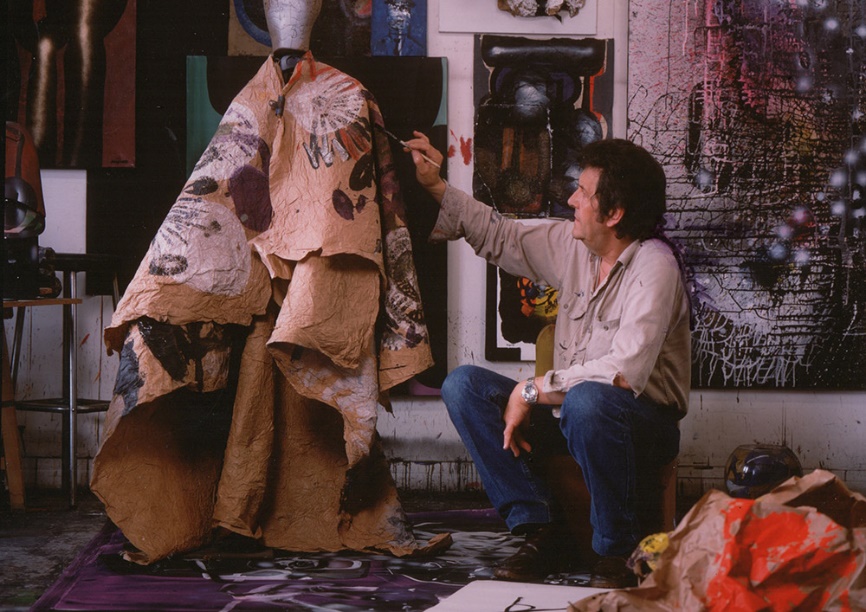
Kijno working on a crumpled paper on a mannequin, Saint Germain en Laye studio
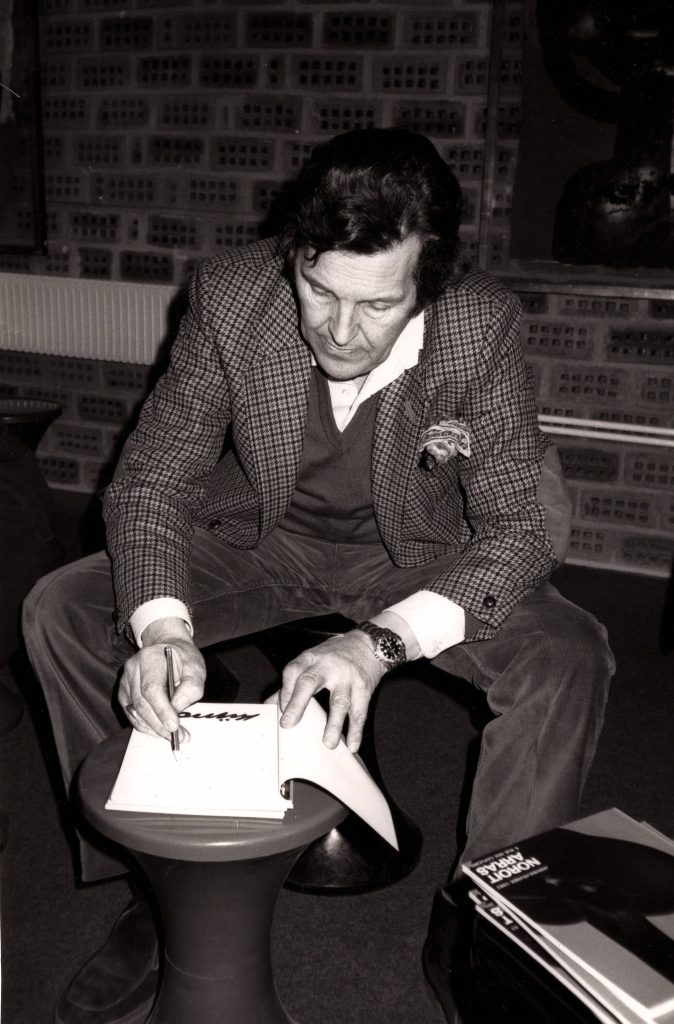
(Kijno at Le Noroit in Arras in 1983)
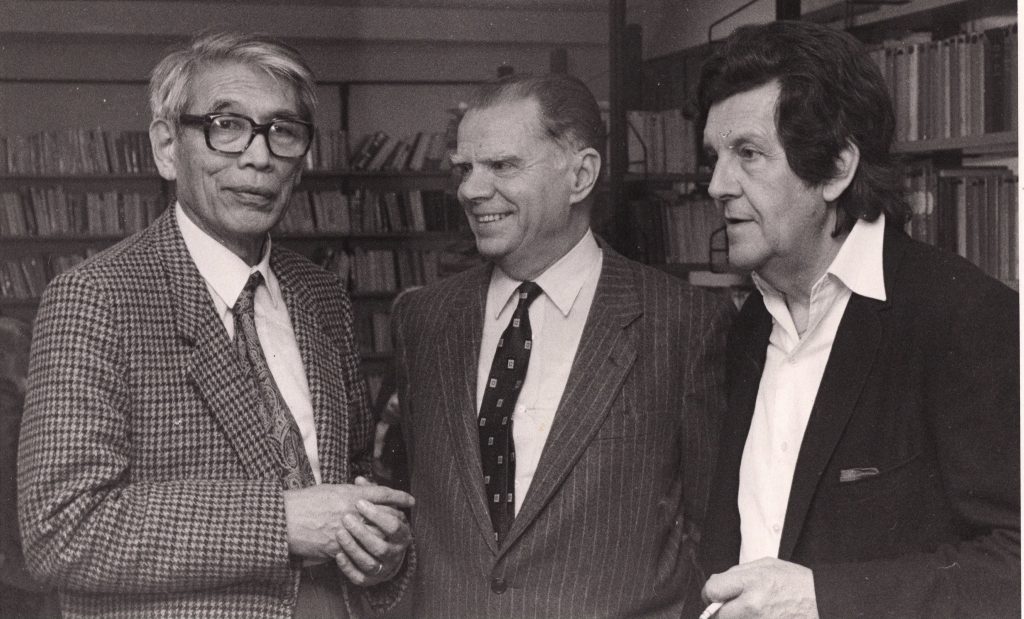
Chu Teh Chun, the “French Ambassador to Luxembourg R.J. Meadmore and Kijno, French Embassy in Luxembourg for the” exhibition “Return from China” presented by the French Embassy in the Grand Duchy of Luxembourg in 1984.
1985
First presentations in France of the Neruda Theatre (exhibited at the Venice Biennale in 1980) and the variations on the Riace bronzes (created in Italy in 1981) at the Museum of Contemporary Art in Dunkirk. Jack Lang awards Kijno the distinction of Officer of Arts and Letters.
1986
Kijno, thirty years already. 1956-1986, retrospective at the Toulon Museum (Var). At this time, Doctors Nerina and Charles Profizi, who were behind this retrospective, introduce him to Professor David Khayat, from the oncology center of the Salpêtrière Hospital in Paris, with whom he undertakes a long experiment on the possible beneficial influence of art in accompanying treatments for certain long-term illnesses; Kijno calls on several of his painter and sculptor friends to participate in this research.
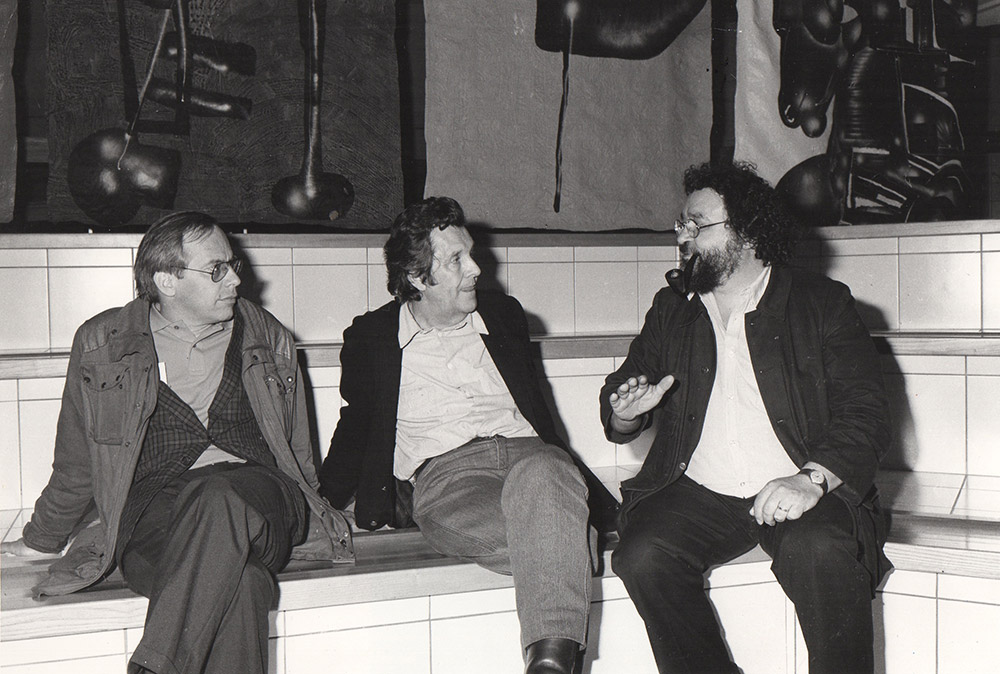
LAAC, Dunkirk, Gilles Plazy, Kijno, Raoul-Jean Moulin
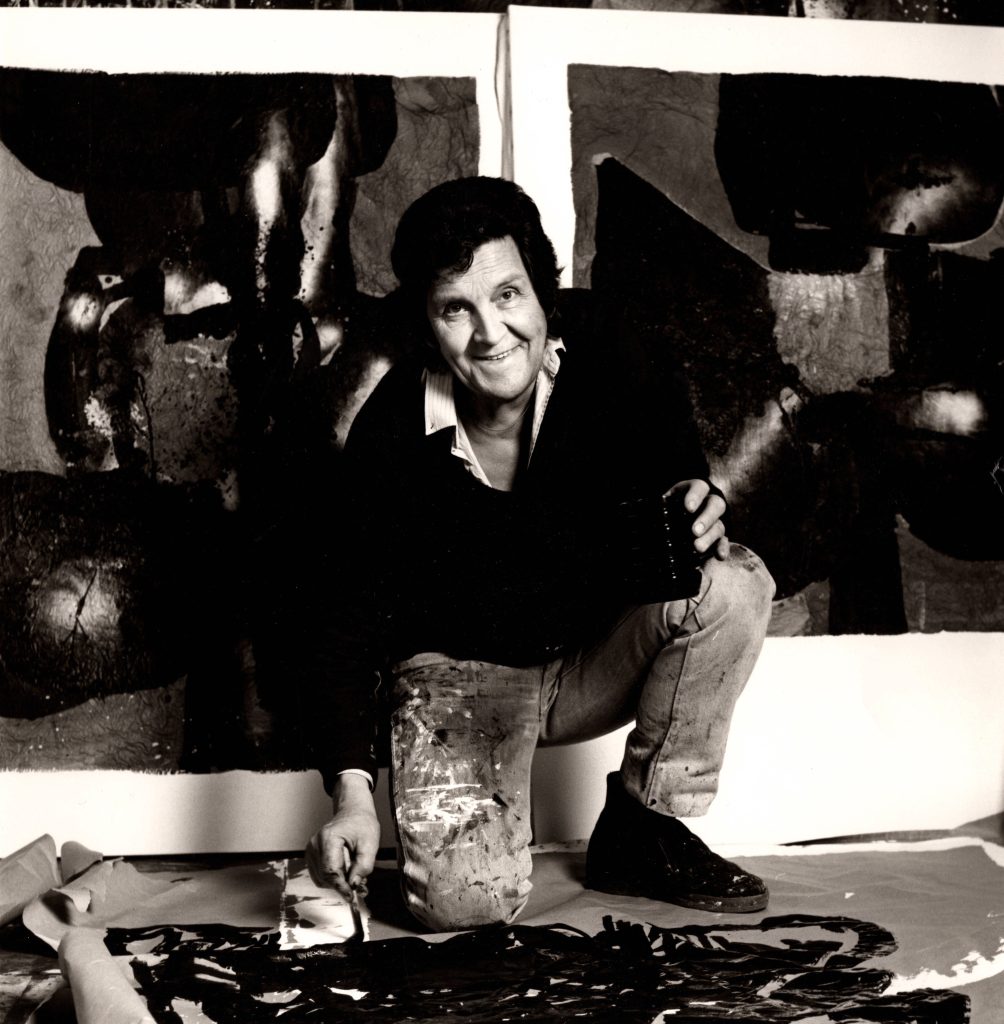
(Kijno in his studio, 1986, photo credit Gaston)
1987
Kijno works on the poetry of André Rochedy and Geneviève Raphanel. “Return from China III”, exhibition at the Château de Vascœuil Foundation, by Master François Papillard.
1988
President François Mitterrand awards him the Legion of Honor. Invited as part of the Atelier des Tropiques by Gilles Arthur to the Gauguin Museum in Tahiti.
1989
Presentation of the Great Icon in Homage to Michelet by Master Papillard at Château Vascœuil. Exhibition of thirty variations on crumpled newspaper, created from Gauguin’s paintings at the Gauguin Museum in Tahiti. Introduction by Gilles Artur.
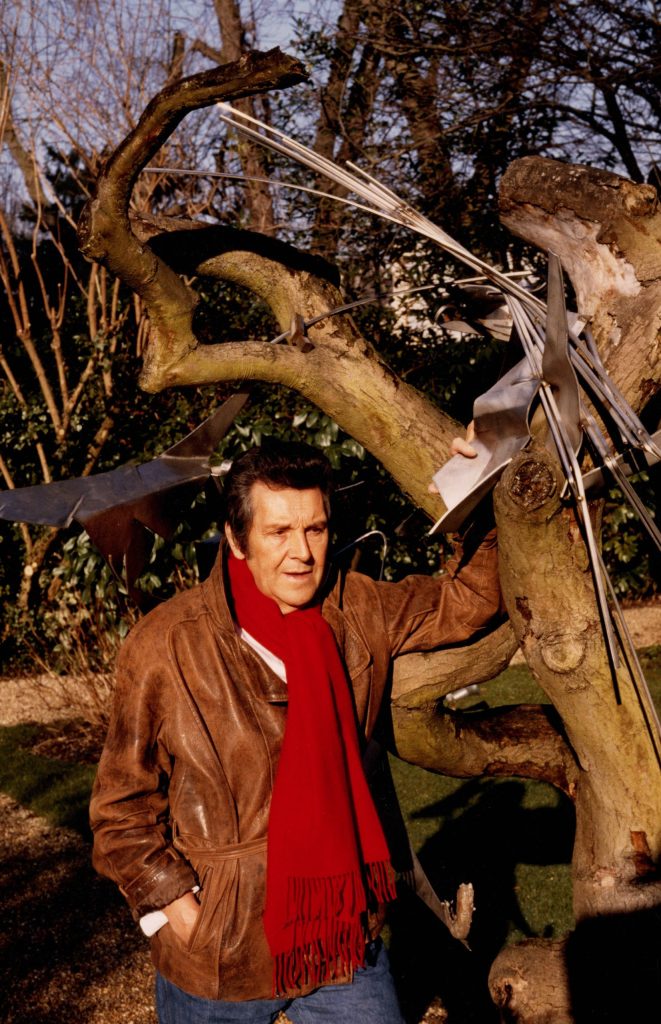
(Kijno 1989, Photo by Michel Marizy)
1990
Third stay in Tahiti and at the Gauguin Museum. Works with Messagier and the children of Paul Fort School in Villeneuve d’Ascq, a school run by Bernard Paccou. On this occasion, he creates with the students the largest crumpled paper in the world (36 meters) deployed over the entire height of the Museum of Contemporary Art in Dunkirk. A video documents this performance. Kijno is invited by Monsignor Vilnet to create the rose window for the west facade of Notre-Dame de la Treille Cathedral in Lille, alongside architect Pierre-Louis Carlier, in a structure by Peter Rice (creator of Pei’s Louvre Pyramid) and sculptor Jean Clos for the bronze portal.
In Tahiti, at the Gauguin Museum, Kijno becomes friends with Reine and Victor Merlhes (specialist in Gauguin’s correspondence).
1991
New stay in Tahiti as part of the Atelier des Tropiques at the Gauguin Museum.
1992
New stay in Tahiti where he increasingly wishes to settle permanently. Daniel Lemaitte, who directs the grand atelier of plastic arts in Feignies in the North, organizes a Kijno/Jean Pierre Jouffroy exhibition. Jouffroy initiated Kijno to rotary engraving on rhodoid.
1993
Michael Lonsdale reads poems by Geneviève Raphanel and André Rochedy, in front of the Last Supper painted by Kijno for the Church of Assy. For this occasion, the painting was brought up from the crypt and placed in the heart of the church, in front of Germaine Richier’s Christ and Lurçat’s tapestry between Matisse and Bonnard. Stay in Tahiti and exhibition at the Gauguin Museum organized by Gilles Arthur and Patrice Bredel. In Canada, exhibition “First Signs or the Mixing of Cultures”, with Riopelle and Chu Teh Chun, organized by Gilbert Erouart from the cultural service of the French Embassy. On this occasion, Kijno and Chu Teh Chun stay and exhibit in Quebec and with the Montagnais Amerindians. Frequent meetings with Riopelle are organized.
1994
Traveling exhibition “First Signs” in Canada with Riopelle and Chu Teh-Chun.
1996
Raoul-Jean Moulin presents three illustrations by Kijno created in correlation with Salah Stétié and the painting Great Icon for All Children Who Die Every Day from Hunger and Misery.
1997
Publication of the monograph Kijno by Raoul-Jean Moulin by Editions Cercle d’art, a reference work on the artist and his work.
1998
Kijno participates in the tribute to his philosophy master Jean Grenier, at the history museum and municipal library of Saint-Brieuc.
1999
The inauguration of Notre Dame de la Treille Cathedral in Lille takes place on December 19. Kijno’s rose window and Jeanclos’ portal are set in a structure by Peter Rice. Architect Pierre-Louis Carlier.
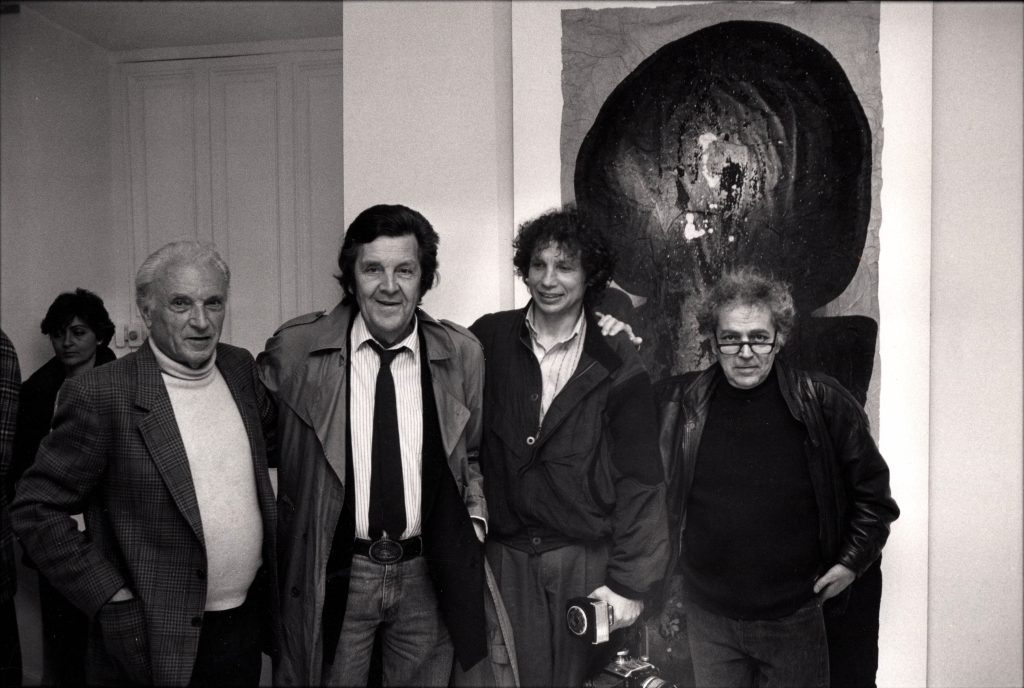
(Kijno with Alkis Voliotis, André Villers, photo by Yves Gallois, Galerie Sapone, Nice 1990)

(Kijno 1990, photographer Benjamin Auger)
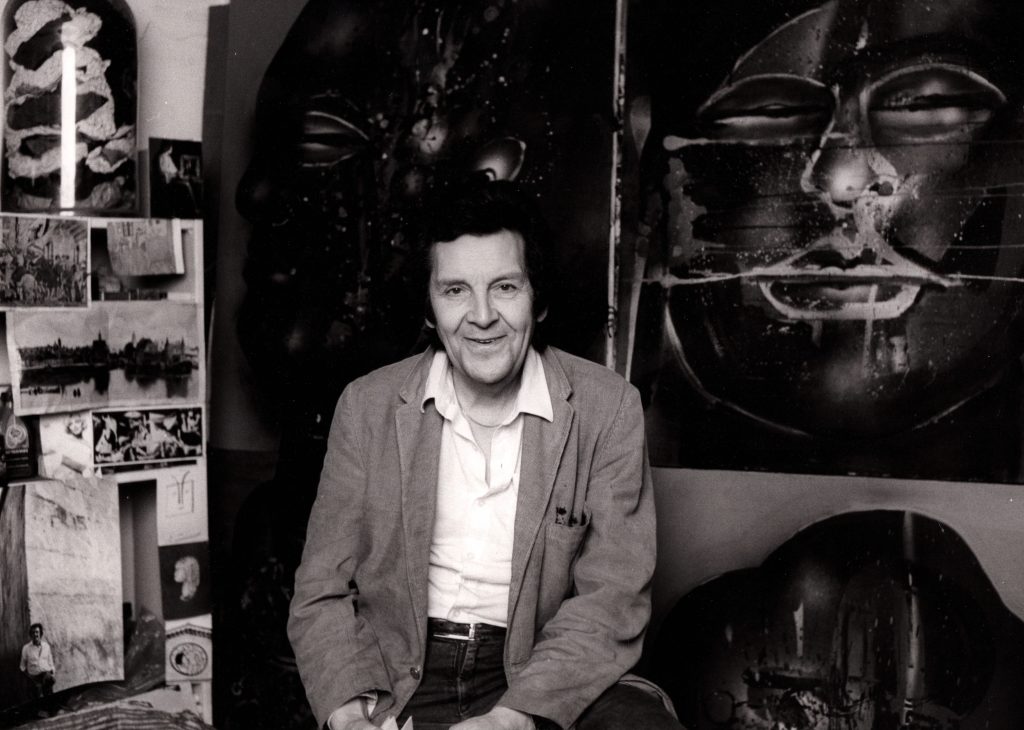
(Kijno in his studio in Saint Germain-en-Laye 1990s)
2000
Retrospective at the Palais des Beaux-Arts in Lille.
2001
Retrospective at the Paul Valery Museum in Sète.2002
Kijno works on the important series of 70 crumpled papers under the title Psychoanalytic Variations on Tristan Tzara.
Establishes a relationship with French cosmonaut Patrick Baudry. A long dialogue is established between them on the relationship between celestial space and the space of the canvas. Baudry asks Kijno to write the preface to his book The Dream and Space, published by Éditions du Chêne.
Creation of a series of 60 Buddhas with sculptor Jean-Pierre Rives
2003
Stations of the Cross of Love, Kijno paintings and drawings, Bernard Noël text and poems, Galerie Sapone, Nice.
2004
Creation of the “Kijno Space” in Sin-le-Noble after the one at La Paix d’Auberchicourt nursery school in the North and before the one in Nœux-les-Mines (Pas-de-Calais). Éditions Maeght presents in Paris the book Sonnets of Death 7 poems by Bernard Noël 7 lithographs by Kijno.
2005
Combas and Kijno complete the Stations of the Cross on which they have worked for nearly 2 years. Indeed, for several years they have been creating series of interwoven works. Kijno exhibits at the museum of Vitry-sur-Seine (Val de Marne) and at the Museum of Contemporary Art in Dunkirk.
2006
Retrospective at Saint Michael’s Castle, Russian State Museum in Saint Petersburg. The Combas/Kijno Stations of the Cross is presented at the Saint-Louis des Gobelins Chapel in Paris and then at the Espace Bagouet in Montpellier. Kijno donates 16 paintings to the city of Noeux-Les Mines where he spent his childhood. Exhibition “Hans Hartung-Ladislas Kijno, the 1960s”, in collaboration with Galerie Sapone, Art Paris.
2008
Kijno donates to the city of Lille the Neruda Theater, a set of 30 crumpled canvases.
REGGIA DI CASERTA “Riace Bronzes” in collaboration with Antonio Sapone
2012
Exhibition Ladislas Kijno, The Great Works at the La Malmaison Art Center in Cannes.
Ladislas Kijno passes away on November 27, 2012 in his house in Saint Germain en Laye. He never stopped connecting his pictorial adventure to that of poets: Tristan Tzara, Louis Aragon, Francis Ponge, Nikos Kazantzaki, Salah Stétié, Bernard Noël, François Xavier…
2013
Kijno/Combas Exhibition, Château de Vascoeuil. Kijno/Angela Davis Exhibition at the Black Basque Festival in Bayonne with the creation of a collective graffiti in tribute to Kijno by artists from the 9th Concept.
2015
Kijno Retrospective at the Touquet Museum.
2016
Exhibition At the Sources of Street Art: Kijno, Villeglé, Ben, Les Tournesols Gallery, Saint-Etienne. Kijno: Negro Spiritual, Dorval Gallery Lille.
2017
The city of Saint-Germain-en-Laye proposes to Malou Kijno to organize a retrospective of her husband at the Royal Riding School, at Espace Vera, at the Media Library and at La Clef.
2024
The Bina endowment fund, created by the artist’s rights holder to promote and enhance his work, finances various Kijno exhibitions in his childhood lands, curated by Renaud Faroux: a retrospective exhibition at LaBanque in Béthune, an exhibition at La Cité des Électriciens in Bruay-la-Buissière, one at the Comédie de Béthune, and one at the Maison de la Poésie in Beuvry. The Béthune metropolitan area celebrates this “Kijno year” by organizing various events and activities over several months.
A scientific committee chaired by Serge Lemoine, professor emeritus at the Sorbonne and former director of the Grenoble Museum and the Musée d’Orsay, is created to produce the catalogue raisonné of the artist’s work, entrusted to art historian Céline Berchiche.